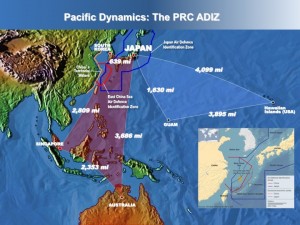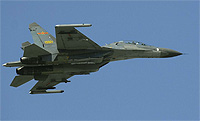2013-12-04 by Ed Timperlake
The Peoples Republic of China by asserting an Air Defense Identification Zone (ADIZ) over the East China Sea has just defined an air engagement zone outside of territorial Mainland China and over international water.
The PRC Air Defense Identification Zone may seem an anomaly or an irrational act challenging multiple players in the Pacific.
But what it is in reality is the opening gambit in trying to impede and defeat the formation of a 21st century Pacific defense and security strategy by the U.S. and its allies.
In addressing PLA intentions and capabilities bundled with such an action, it is important to understand their previous engagements on perceived border disputes:
- South Korea, DMZ 1950
- Republic of China, Tachen Islands –Quemoy Matsu 1954 and again 1958
- India, “Roof of the World” 1962
- Russia, Ussuri River 1969
- Vietnam, Northern Border 1979
(One can also add the approach to their own people seen in the actions in Tiananmen Square and 450 other cities in China, 1989).
Each of the countries mentioned at one point in time had a military exchange with the Peoples Liberation Army.
Each engagement was described as a border conflict. That is except Tiananmen Square and the 450 other cities that erupted in China. That combat was an effort by the Peoples Liberation Army, a political army with allegiance to the Communist Party, to declare war on an idea and not a border. The idea was simple the quest for freedom for the citizens of China.
Each engagement left a legacy of PLA fighting experience and performance.
The results were very mixed but culturally each country mentioned had a moment in time fighting the PLA. Now with the announcement by the PRC of an East China Sea Air Defense Identification Zone (ADIZ) with a suspected South China Sea ADIZ expected the PRC has gone “feet wet” over a nautical border issue.
The history of PLA border wars has left a powerful legacy among each nation mentioned.
Japan was left off of the list because an unrelenting goal of PRC “information war” is to keep the legacy of WW II Imperial Japan alive. What the leaders of China fail to grasp is that America is a nation of immigrants, a country made up of citizens who are most generally optimistic and understand to their core the grace of forgiveness and second chances.
Japan is a great example of a vibrant free nation which emerged from the horror of WW II, with a pacifist constitution, but make no mistake when bullied can fight. Americans respect that cultural dynamic.
Japan does have a wartime history with China.
So if China wants to attack or push aggressively against Japan for events seventy years ago in spite of the significant difference with the current Japanese strategic realities, then one should look at the much more significant impact of the Chinese past on the Chinese present.

PRC history includes the brutal fact that Mao according to the Black Book Of Communism is the leading mass murder of all time. And the facts are China is still being ruled by that legacy, and Japan is not.
It is that simple.
The practical result of the announced ADIZ is to bring together is many different ways all the nations who have had combat engagements with the PLA.
In this dynamic of nations taking steps for their self-defense there are some very interesting factors in this century.
First looking briefly at military modernization, the US, Japan and South Korea will be joint partners in the F-35 global enterprise. US and Japan jointly operate AEGIS ships. Recently the USMC MV-22 has had cross deck operations with JSDF ships in the Pacific. The US and India are both part of the P-8 aircraft family. And Russia, in addition to selling military weapons, planes and ships to China is also selling their “Black Hole” Kilo subs to Vietnam.
Contrary to PRC bluster and threats the US and the Republic of China (Taiwan) a free open vibrant democracy, share weapons and information.
And the US and Allied Tanker Fleets in the Pacific make a seminal difference in military operational con-ops in the Pacific “quadrangle.”
The real world military consequences to the Peoples Republic of China of their ADIZ gambit is that by venturing “feet wet”, the PLA engagement will provide a treasure trove of information.
The PLA, essentially the PLAAF with support from ground and perhaps PLAN ships, will now have to reach out to enforce their ADIZ.
All the nations that China has picked a fight with will formally or informally get valuable information on how PLA forces really operate over international waters and in international airspace.

Turn about is fair play.
The US and Allies had to respond to the North Korean missile threats and in doing so revealed significant operational information to PRC electronic collection network.
The PLA by capturing “signals in space” and by looking at satellite images of tactical ship and aircraft movements gained some insights with regard to US and allied approaches and capabilities.
What would the PRC have gained from North Korea’s long-telegraphed missile tests?The answer is simple: an intelligence bonanza for the PRC.
As a result of the tests, the PRC got a free look at U.S. capabilities. The PRC saw which military resources the U.S. committed, which tactical weapons were deployed, (ships, air and land-based systems), which frequencies used (to be jammed in time of war). They also got to see how quickly and accurately we identified and tracked the North Korean missiles.
And that’s not all.
The PRC also got to see if how well state-of-the-art U.S. intelligence and communications systems operated in a crisis. They could also see if the U.S. is exporting degraded systems. They could see if allied weapon systems were successfully integrated into joint operations.
The bottom line is pretty clear: North Korea’s missile barrage was an extraordinary opportunity for the Peoples Liberation Army to capture invaluable information about U.S. and allied military capabilities.
Now it is time for a look at PLAAF flying skills, their command and control doctrine, formations used weapons carried, skill of PLAN ships, PLAAF airborne and ground station search, acquisition and vectoring networks.
Everything necessary in real world actions to enforce an ADIZ will have to be demonstrated by the PLA.
The US and the Pacific Allies have very capable combat Fighter Pilots and also very capable “tron” collecting airborne aircraft, electronic warfare collection ships, along with ground collection stations and space assets.
Can NSA be of help?
It is time for a real world look at China’s capability to scramble, vector, shadow and possibly engage. Time for skilled and experience fighter pilot experts to get a look—organizations such AF project “Checkmate”, the AF weapons School, Top Gun and MAWTS (USMC Top Gun) to get a look at the “big picture ” look and analysis of PRC/PLA/PLAAF/PLAN skills in action operating at a distance.
A fundamental lesson of the Cold War rivalry is that a nation must be able to adjust during the course of an air battle or war by changing strategy and tactics, to achieve exploitation of the enemy’s mistakes or weakness. Aircrews must be adaptable enough to follow changing commands from leadership and also, on their own initiative, to change tactics to achieve local surprise and exploitation.
Watching the PLA in the ADIZ not only gives real time information but it also allows our allies and others to filter the information trough their cultural viewpoint and remember they all have engaged China in combat. Their insights are extremely valuable so everyone is not thinking alike about key vulnerabilities to PLA combat operations.
Welcome to engaging “feet wet” in the strategic quadrangle.
An air-to-air engagement totally slaved to a ground controlled radar attack, the USSR model was a colossal failure and deadly to a lot of pilots locked into such a system. A bottom-up approach with evolving aircraft system capabilities in a competitive airframe makes for adaptive, creative aircrews that will have a large repertoire of tactical moves and a better chance of getting inside an opponent’s OODA loop. This is true for both air-to-air and air-to-ground combat missions.
As the history of war in the air shows it was a constantly evolving process of human factors integrated into technology. The Cold War ended well for humanity and a lot of courageous pilots, bold leaders, and smart technologists deserve a lot of credit for this great victory.
Now in this 21st century engagement triggered by the PRC, the US and its allies can engage in flying engagements to determine the approach and capabilities of the PLA in real near combat conditions.
Editor’s Note: Below are two recent briefings we have provided for our readers on the evolution of PRC military capabilities.

